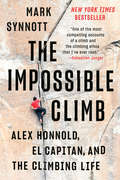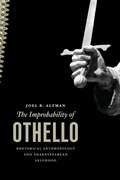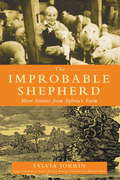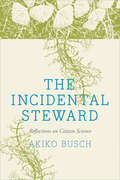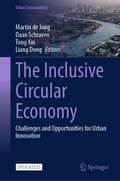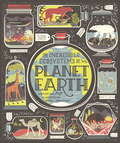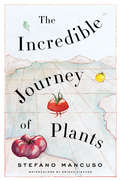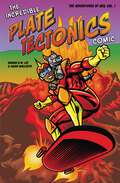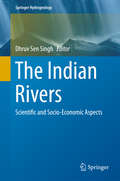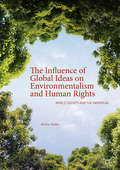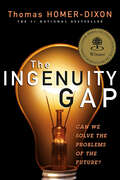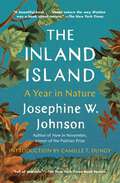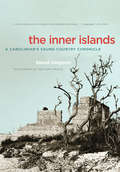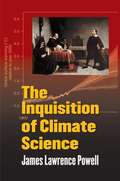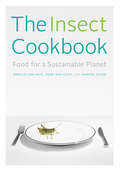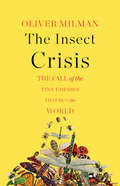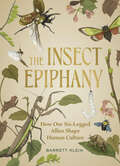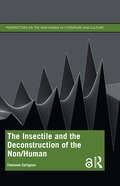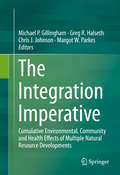- Table View
- List View
The Impossible Climb: Alex Honnold, El Capitan, and the Climbing Life
by Mark SynnottIf you loved watching Free Solo, you’ll be enthralled by Mark Synnott’s deeply reported, insider perspective."One of the most compelling accounts of a climb and the climbing ethos that I've ever read."--Sebastian JungerIn Mark Synnott’s unique window on the ethos of climbing, his friend Alex Honnold’s astonishing “free solo” ascent of El Capitan’s 3,000 feet of sheer granite, is the central act. When Honnold topped out at 9:28 A.M. on June 3, 2017, having spent fewer than four hours on his historic ascent, the world gave a collective gasp. The New York Times described it as “one of the great athletic feats of any kind, ever.” Synnott’s personal history of his own obsession with climbing since he was a teenager—through professional climbing triumphs and defeats, and the dilemmas they render—makes this a deeply reported, enchanting revelation about living life to the fullest. What are we doing if not an impossible climb?Synnott delves into a raggedy culture that emerged decades earlier during Yosemite’s Golden Age, when pioneering climbers like Royal Robbins and Warren Harding invented the sport that Honnold would turn on its ear. Painting an authentic, wry portrait of climbing history and profiling Yosemite heroes and the harlequin tribes of climbers known as the Stonemasters and the Stone Monkeys, Synnott weaves in his own experiences with poignant insight and wit: tensions burst on the mile-high northwest face of Pakistan’s Great Trango Tower; fellow climber Jimmy Chin miraculously persuades an official in the Borneo jungle to allow Honnold’s first foreign expedition, led by Synnott, to continue; armed bandits accost the same trio at the foot of a tower in the Chad desert . . .The Impossible Climb is an emotional drama driven by people exploring the limits of human potential and seeking a perfect, choreographed dance with nature. Honnold dared far beyond the ordinary, beyond any climber in history. But this story of sublime heights is really about all of us. Who doesn’t need to face fear down fear and make the most of the time we have?
The Improbability of Othello: Rhetorical Anthropology and Shakespearean Selfhood
by Joel B. AltmanShakespeare’s dramatis personae exist in a world of supposition, struggling to connect knowledge that cannot be had, judgments that must be made, and actions that need to be taken. For them, probability—what they and others might be persuaded to believe—governs human affairs, not certainty. Yet negotiating the space of probability is fraught with difficulty. Here, Joel B. Altman explores the problematics of probability and the psychology of persuasion in Renaissance rhetoric and Shakespeare’s theater.Focusing on the Tragedy of Othello, Altman investigates Shakespeare’s representation of the self as a specific realization of tensions pervading the rhetorical culture in which he was educated and practiced his craft. In Altman’s account, Shakespeare also restrains and energizes his audiences’ probabilizing capacities, alternately playing the skeptical critic and dramaturgic trickster. A monumental work of scholarship by one of America’s most respected scholars of Renaissance literature, The Improbability of Othello contributes fresh ideas to our understanding of Shakespeare’s conception of the self, his shaping of audience response, and the relationship of actors to his texts.
The Improbable Shepherd
by Sylvia Jorrin Joshua Kilmer-Purcell"The lessons of Sylvia's farm are not just applicable for those who dream of living the rural life. They're universally instructive, and joyfully addictive." --Joshua Kilmer-Purcell, The Fabulous Beekman BoysIn this sequel to her popular first collection, Sylvia Jorrín returns with more vignettes -- along with personal photos, artwork, and recipes--from her life on thefarm to again inspire readers old and new. The Improbable Shepherd is a continuation of Sylvia's Farm, covering the past five years of her experiences on a rural sheep farm. This book brings readers closer to the world around them, and to recognize the simple, often hidden beauties it holds. Told in short vignettes and anecdotes, it is a journal of the continuing growth, persistence, and hope that each new day can bring.Nearly a decade after the publication of her first book, life on Sylvia Jorrin's farm continues to present our improbable shepherdess with new opportunities to appreciate the peace and unexpected joys that farm life brings despite too many tasks and too little time.The Improbable Shepherd immerses the reader fully in Sylvia's farm, echoing her own experiences living with the land and includes photos, and illustrations and Sylvia's personal recipes. Appealing to those who loved Sylvia's first book and want to return, as well as for all the newcomers who have yet to discover Sylvia's powerful prose and earnest message, The Improbable Shepherd will inspire you to follow your dreams, whatever they may be.
The Incidental Steward: Reflections on Citizen Science
by Akiko BuschA search for a radio-tagged Indiana bat roosting in the woods behind her house in New York's Hudson Valley led Akiko Busch to assorted other encounters with the natural world--local ecological monitoring projects, community-organized cleanup efforts, and data-driven citizen science research. Whether it is pulling up water chestnuts in the Hudson River, measuring beds of submerged aquatic vegetation, or searching out vernal pools, all are efforts that illuminate the role of ordinary citizens as stewards of place. In this elegantly written book, Busch highlights factors that distinguish twenty-first-century citizen scientists from traditional amateur naturalists: a greater sense of urgency, helpful new technologies, and the expanded possibilities of crowdsourcing. The observations here look both to precisely recorded data sheets and to the impressionistic marginalia, scribbled asides, and side roads that often attend such unpredictable outings. While not a primer on the prescribed protocols of citizen science, the book combines vivid natural history, a deep sense of place, and reflection about our changing world. Musing on the expanding potential of citizen science, the author celebrates today's renewed volunteerism and the opportunities it offers for regaining a deep sense of connection to place.
The Inclusive Circular Economy: Challenges and Opportunities for Urban Innovation (Urban Sustainability)
by Liang Dong Martin De Jong Daan Schraven Tong XinThis open access book is a multi-disciplinary effort to address the complex socio-economic issues and the substantial environmental pressure that the expected large-scale migration will exert on cities in the near future. Emerging from a joint research project between China and the Netherlands, the authors herein put forward a vision for cities that the future demands while assessing efforts, recent and ongoing, in this direction. Building on the lessons learned from this research, it also proposes strategies and best practices for future policy aimed at the design and development of circular and inclusive cities.
The Incredible Ecosystems of Planet Earth
by Rachel IgnotofskyAn illustrated tour of our planet's ecosystems both large and small, from reefs, deserts and rainforests to a single drop of water - from the bestselling author of Women in Science. Through exquisite illustrations, maps and infographics, bestselling author Rachel Ignotofsky explains how our planet works, from its incredible ecosystems and the plants and animals that live there to the importance of biodiversity, weather cycles and more. Including information on the dangers of climate change and ideas for how to protect Planet Earth, this utterly charming guide is the perfect gift for all nature-loving readers on the planet we call home.
The Incredible Journey of Plants
by Stefano MancusoIn this richly illustrated volume, a leading neurobiologist presents fascinating stories of plant migration that reveal unexpected connections between nature and culture.When we talk about migrations, we should study plants to understand that these phenomena are unstoppable. In the many different ways plants move, we can see the incessant action and drive to spread life that has led plants to colonize every possible environment on earth. The history of this relentless expansion is unknown to most people, but we can begin our exploration with these surprising tales, engagingly told by Stefano Mancuso. Generation after generation, using spores, seeds, or any other means available, plants move in the world to conquer new spaces. They release huge quantities of spores that can be transported thousands of miles. The number and variety of tools through which seeds spread is astonishing: we have seeds dispersed by wind, by rolling on the ground, by animals, by water, or by a simple fall from the plant, which can happen thanks to propulsive mechanisms, the swaying of the mother plant, the drying of the fruit, and much more. In this accessible, absorbing overview, Mancuso considers how plants convince animals to transport them around the world, and how some plants need particular animals to spread; how they have been able to grow in places so inaccessible and inhospitable as to remain isolated; how they resisted the atomic bomb and the Chernobyl disaster; how they are able to bring life to sterile islands; how they can travel through the ages, as they sail around the world.
The Incredible Plate Tectonics Comic: The Adventures of Geo, Vol. 1
by Adam Wallenta Kanani K. LeeThe Incredible Plate Tectonics Comic is a wild adventure in earth science. Follow Geo and his robot dog, Rocky, as they travel back in time to Pangea, surf a tsunami, and escape an erupting volcano—all in time for Geo’s first-period science test!The journey starts 200 million years ago and takes you to modern-day Hawai’i, the ocean floor, and deep inside the Earth.You’ll learn:–How scientists developed the theory of plate tectonics–Why the Earth shakes–What’s in the center of the Earth–How volcanoes can form islandsThe Incredible Plate Tectonics Comic will teach you about geology in a fun, lively, and visual way.Ages 8+. Recommended for grade 6 and up
The Indian Rivers: Scientific and Socio-economic Aspects (Springer Hydrogeology)
by Dhruv Sen SinghThe book presents geomorphological studies of the major river basins - the Indus, Ganga and Brahmaputra and their tributaries. Besides major basins, the book explores peninsular rivers and other rivers state-by-state. All types of rivers, i. e. snow-fed, rain-fed and groundwater-fed rivers are explained together in geological framework. Rivers are lifeline and understanding of the rivers, their dynamics, science and socio-economic aspect is very important. However, different sources provide different data base for rivers. But a book which explains all major rivers of a country at a single place was not yet available. This book is the first book of its kind in the world which provides expert opinion on all major rivers of a country like India. This book complements works in these areas for the last two to three decades on major rivers of India by eminent professors and scientists from different universities, IITs and Indian research institutions. The information presented in the book would appeal to a wider readership from students, teachers to researchers and planners engaged in developmental work and also to common people of the society concerned with awareness about rivers.
The India–Korea CEPA: An Analysis of Industrial Competitiveness and Environmental and Resource Implications (SpringerBriefs in Economics)
by Sudhakar Yedla Choongjae ChoThis book assesses the changes that the Comprehensive Economic Partnership Agreement (CEPA) could produce by boosting the competitiveness of firms in India and Korea. It evaluates the CEPA in terms of its effects on the environment and natural resources of the importing and exporting countries alike. Further, it employs the revealed comparative advantage (RCA) and relative trade advantage (RTA) methods of analysis to gauge the influence of the CEPA on industrial competitiveness in both host and receiving countries. While the CEPA would increase trade between India and Korea in their respective strong domains, the book argues that, given the nature of the exported and imported goods and products, India would be more susceptible to serious environmental impacts than would Korea. The book subsequently presents these impacts in a qualitative framework and stresses the need for a comprehensive valuation of not only environmental impacts, but also the losses due to tariff cuts and the gains due to increased trade between the two countries.
The Industrial Base for Carbon Dioxide Storage: Status and Prospects
by David S. Ortiz Constantine Samaras Edmundo Molina-PerezIf policies aimed at large reductions of carbon dioxide (CO2) emissions are enacted, more carbon capture and storage will be needed. RAND researchers explored the ability of the industrial base supporting the transportation and sequestration of CO2 to expand, assessing the industrial base for transportation and injection of CO2 for both geologic storage and enhanced oil recovery.
The Influence of Global Ideas on Environmentalism and Human Rights
by Markus HadlerThis book explores whether individual attitudes and behaviors are swayed by global developments in a world increasingly populated by organizations, treaties, and other institutions that focus on environmentalism and human rights. It uses the sociological approach of World Society theory to investigate the effects of global ideas on individual environmentalism, xenophobia, and homophobia while drawing its data from a variety of international public opinion surveys. The Influence of Global Ideas on Environmentalism and Human Rights questions the dominant narrative of World Society related research as a positive influence of global ideas on various outcomes. Hadler demonstrates the complexity of this issue through empirical analyses revealing mixed trends in attitudes and behaviors from around the world. This book will be of interest to academics seeking to critically engage with World Society theory through two of its core topics: human rights and environmentalism.
The Ingenuity Gap: Can We Solve the Problems of the Future?
by Thomas Homer-DixonAs crises multiply, ingenuity lags. This prescient classic explains why societies falter when problems outpace solutions—and offers a roadmap to close the gap before risks from climate shocks, pandemics, inequality, and AI spiral beyond control.First published at the turn of the millennium, The Ingenuity Gap by Thomas Homer-Dixon anticipated the turbulent world we now inhabit: pandemics, climate disasters, political polarization, disruptive runaway technologies, and escalating global instability. With remarkable foresight, Homer-Dixon warned that the complexity of our problems would accelerate faster than our collective ingenuity to solve them—and that failure to close this &“gap&” would leave societies fragile and exposed. A quarter century later, his vision has proven prophetic.Homer-Dixon takes readers on a global tour of ingenuity under pressure: from the desperate improvisation of pilots fighting to land United Airlines Flight 232 in Iowa, to the water-hungry expansion of Las Vegas, to a harrowing search for a missing child in Patna, and the collapse of Canada&’s cod fisheries. Vivid and far-reaching, it is a sweeping portrait of what happens when societies are stretched beyond their capacity to adapt and an enlightening case for why ingenuity is humanity&’s most vital resource.Celebrating over twenty-five years in print, The Ingenuity Gap remains both a visionary diagnosis of our age and a call to reimagine how we generate creativity, resilience, and leadership in uncertain times.
The Inland Island: A Year in Nature
by Josephine Johnson&“A beautiful book...about nature the way Walden was a book about nature. It should be read by everyone who still retains the capacity to feel anything&” (The New York Times). Stunningly written and fiercely observed, a new edition of a classic work of nature writing about a year on an Ohio farm, by Pulitzer Prize–winning author Josephine Johnson.Originally published in 1969, The Inland Island is Josephine W. Johnson&’s startling and brilliant chronicle of nature and the seasons at her rambling thirty-seven-acre farm in Ohio, which she and her husband reverted to wilderness with the help of a state forester. Over the course of twelve months, she observes the changing landscape with a naturalist&’s precision and a poet&’s evocative language. Readers will marvel at the way she brings to life flashes of beauty, the inexorable cycle of growth and decay, and the creatures who live alongside her, great and small. A forerunner of iconic American women nature writers and a champion of civil rights who marched in Washington against the Vietnam war, Johnson intersperses these &“delicate marvels&” (The New York Times) with profound reflections about racial inequality, urbanization, social justice, and environmental destruction that speak powerfully to our time. Ready to be rediscovered by a new generation, The Inland Island is a vital and relevant meditation on nature and time, capturing the wonder, beauty, hope—and flaws—of our turbulent world.
The Inner Coast: Essays
by Donovan HohnPrize-winning essays on our changing place in the natural world by the best-selling author of Moby-Duck. Writing in the grand American tradition of Annie Dillard and Barry Lopez, Donovan Hohn is an “adventurous, inquisitive, and brightly illuminating writer” (New York Times). Since the publication of Moby-Duck a decade ago, Hohn has been widely hailed for his prize-winning essays on the borderlands between the natural and the human. The Inner Coast collects ten of his best, many of them originally published in such magazines as the New York Times Magazine and Harper’s, which feature his physical, historical, and emotional journeys through the American landscape. By turns meditative and comic, adventurous and metaphysical, Hohn writes about the appeal of old tools, the dance between ecology and engineering, the lost art of ice canoeing, and Americans’ complicated love/hate relationship with Thoreau. The Inner Coast marks the return of one of our finest young writers and a stylish exploration of what Guy Davenport called “the geography of the imagination.”
The Inner Islands
by Bland Simpson Ann Cary SimpsonBlending history, oral history, autobiography, and travel narrative, Bland Simpson explores the islands that lie in the sounds, rivers, and swamps of North Carolina's inner coast. In each of the fifteen chapters in the book, Simpson covers a single island or group of islands, many of which, were it not for the buffering Outer Banks, would be lost to the ebbs and flows of the Atlantic. Instead they are home to unique plant and animal species and well-established hardwood forests, and many retain vestiges of an earlier human history.
The Inquisition of Climate Science
by James Lawrence PowellScience is under the greatest and most successful attack in modern history. An industry of denial, abetted by media more interested in selling controversy than presenting facts, has duped half the American public into rejecting the facts of climate science--facts showing that human-caused emissions are warming the Earth. The industry of climate science denial is succeeding: public acceptance has declined even as the scientific evidence for global warming has increased. It is vital that the public understand how anti-science ideologues, pseudoscientists, and non-scientists have bamboozled them. We cannot afford to get global warming wrong, yet thanks to deniers and their methods, we are.Jim Powell's The Inquisition of Climate Science is the first book to take on comprehensively the climate science denial movement and the deniers themselves, exposing their lack of credentials, industry funding, and absence of any alternative theory to explain the observed evidence of warming. In this book, readers meet the most prominent deniers and participate in a dissection of their credentials, arguments, and lack of objectivity. James Lawrence Powell shows that the deniers use a wide variety of deceptive rhetorical techniques, many of them going back to the Greeks. While written for the general reader and non-scientist, this book is carefully researched and fully referenced. Readers with an open mind will learn that the evidence of global warming is real and see that an industry of denial has deceived the American public, putting them and their grandchildren at risk.
The Inquisition of Climate Science
by James PowellModern science is under the greatest and most successful attack in recent history. An industry of denial, abetted by news media and "info-tainment" broadcasters more interested in selling controversy than presenting facts, has duped half the American public into rejecting the facts of climate science—an overwhelming body of rigorously vetted scientific evidence showing that human-caused, carbon-based emissions are linked to warming the Earth. The industry of climate science denial is succeeding: public acceptance has declined even as the scientific evidence for global warming has increased. It is vital that the public understand how anti-science ideologues, pseudo-scientists, and non-scientists have bamboozled them. We cannot afford to get global warming wrong—yet we are, thanks to deniers and their methods.The Inquisition of Climate Science is the first book to comprehensively take on the climate science denial movement and the deniers themselves, exposing their lack of credentials, their extensive industry funding, and their failure to provide any alternative theory to explain the observed evidence of warming. In this book, readers meet the most prominent deniers while dissecting their credentials, arguments, and lack of objectivity. James Lawrence Powell shows that the deniers use a wide variety of deceptive rhetorical techniques, many stretching back to ancient Greece. Carefully researched, fully referenced, and compellingly written, his book clearly reveals that the evidence of global warming is real and that an industry of denial has deceived the American public, putting them and their grandchildren at risk.
The Insect Cookbook
by Marcel Dicke Françoise Takken-Kaminker Arnold Van Huis Henk Van Gurp Diane Blumenfeld-SchaapInsects will be appearing on our store shelves, menus, and plates within the decade. In The Insect Cookbook, two entomologists and a chef make the case for insects as a sustainable source of protein for humans and a necessary part of our future diet. They provide consumers and chefs with the essential facts about insects for culinary use, with recipes simple enough to make at home yet boasting the international flair of the world's most chic dishes.Insects are delicious and healthy. A large proportion of the world's population eats them as a delicacy. In Mexico, roasted ants are considered a treat, and the Japanese adore wasps. Insects not only are a tasty and versatile ingredient in the kitchen, but also are full of protein. Furthermore, insect farming is much more sustainable than meat production. The Insect Cookbook contains delicious recipes; interviews with top chefs, insect farmers, political figures, and nutrition experts (including chef René Redzepi, whose establishment was elected three times as "best restaurant of the world"; Kofi Annan, former secretary-general of the United Nations; and Daniella Martin of Girl Meets Bug); and all you want to know about cooking with insects, teaching twenty-first-century consumers where to buy insects, which ones are edible, and how to store and prepare them at home and in commercial spaces.
The Insect Cookbook: Food for a Sustainable Planet (Arts and Traditions of the Table: Perspectives on Culinary History)
by Marcel Dicke Arnold van Huis Henk van GurpThe Definitive Guide to Insects as a Sustainable Food SourceIn The Insect Cookbook, two entomologists and a chef make the case for insects as a sustainable source of protein for humans and a necessary part of our future diet. They provide consumers and chefs with the essential facts about insects for culinary use, with recipes simple enough to make at home yet boasting the international flair of the world's most chic dishes."Invite politicians to dinner and let them tell the world how delicious it is.... They will proudly go around and say, 'I ate crickets, I ate locusts, and they were delicious.'"—Kofi Annan The Insect Cookbook features delicious recipes and interviews with top chefs, insect farmers, political figures, and nutrition experts, including chef René Redzepi, whose establishment was elected three times as "best restaurant of the world"; Kofi Annan, former secretary-general of the United Nations; and Daniella Martin of Girl Meets Bug. The book contains all you need to know about cooking with insects, where to buy them, which ones are edible, and how to store and prepare them at home and in commercial spaces.
The Insect Crisis: The Fall of the Tiny Empires That Run the World
by Oliver MilmanA devastating examination of how collapsing insect populations worldwide threaten everything from wild birds to the food on our plate. From ants scurrying under leaf litter to bees able to fly higher than Mount Kilimanjaro, insects are everywhere. Three out of every four of our planet’s known animal species are insects. In The Insect Crisis, acclaimed journalist Oliver Milman dives into the torrent of recent evidence that suggests this kaleidoscopic group of creatures is suffering the greatest existential crisis in its remarkable 400-million-year history. What is causing the collapse of the insect world? Why does this alarming decline pose such a threat to us? And what can be done to stem the loss of the miniature empires that hold aloft life as we know it? With urgency and great clarity, Milman explores this hidden emergency, arguing that its consequences could even rival climate change. He joins the scientists tracking the decline of insect populations across the globe, including the soaring mountains of Mexico that host an epic, yet dwindling, migration of monarch butterflies; the verdant countryside of England that has been emptied of insect life; the gargantuan fields of U.S. agriculture that have proved a killing ground for bees; and an offbeat experiment in Denmark that shows there aren’t that many bugs splattering into your car windshield these days. These losses not only further tear at the tapestry of life on our degraded planet; they imperil everything we hold dear, from the food on our supermarket shelves to the medicines in our cabinets to the riot of nature that thrills and enlivens us. Even insects we may dread, including the hated cockroach, or the stinging wasp, play crucial ecological roles, and their decline would profoundly shape our own story. By connecting butterfly and bee, moth and beetle from across the globe, the full scope of loss renders a portrait of a crisis that threatens to upend the workings of our collective history. Part warning, part celebration of the incredible variety of insects, The Insect Crisis is a wake-up call for us all.
The Insect Epiphany: How Our Six-Legged Allies Shape Human Culture
by Barrett KleinFrom entomologist Barrett Klein comes a buzz-worthy exploration of the many ways insects have affected human society, history, and culture Insects surround us. They fuel life on Earth through their roles as pollinators, predators, and prey, but rarely do we consider the outsize influence they have had on our culture and civilization. Their anatomy and habits inform how we live, work, create art, and innovate. Featuring nearly 250 color images—from ancient etchings to avant-garde art, from bug-based meals to haute couture—The Insect Epiphany proves that our world would look very different without insects, not just because they are crucial to our ecosystems, but because they have shaped and inspired so many aspects of what makes us human.
The Insectile and the Deconstruction of the Non/Human (Perspectives on the Non-Human in Literature and Culture)
by Fabienne CollignonThe Insectile and the Deconstruction of the Non/Human defines, conceptualizes, and evaluates the insectile—pertaining to an entomological fascination—in relation to subject formation. The book is driven by a central dynamic between form and formlessness, further staging an investigation of the phenomenon of fascination using Lacanian psychoanalysis, suggesting that the psychodrama of subject formation plays itself out entomologically. The book’s engagement with the insectile—its enactments, cultural dreamwork, fantasy transformations—‘in-forming’ the so-called human subject undertakes a broader deconstruction of said subject and demonstrates the foundational but occluded role of the insectile in subject formation. It tracks the insectile across the archives of psychoanalysis, seventeenth century still life painting, novels from the nineteenth century to the present day, and post-1970s film. The Insectile and the Deconstruction of the Non/Human will be of interest for scholars, graduate students, and upper-level undergraduates in film studies, visual culture, popular culture, cultural and literary studies, comparative literature, and critical theory, offering the insectile as new category for theoretical thought.
The Inspired Garden: 24 Artists Share Their Vision
by Judy PaoliniAn eye for composition, texture, and color, and a willingness to break ordinary garden &“rules.&” These are just some of the talents artists bring to designing their gardens. Artists are also more apt than most green thumbs to see the garden as a place for artistic expression. Inspired Gardens offers a tour of 24 private gardens in New England while offering eye-opening interviews with the artists who designed them. Lavishly illustrated with photographs by Nance Trueworthy, the volume is a visual delight. It is also highly inspirational and eminently informative—an exciting lesson on how artistic principles underlay garden design just as much as they do sculpture, painting, mosaic, or other arts.
The Integration Imperative
by Chris J. Johnson Margot W. Parkes Michael P. Gillingham Greg R. HalsethThe purpose of this work is to develop a better understanding and thinking about the cumulative impacts of multiple natural resource development projects. Cumulative impacts are now one of the most pressing, but complex challenges facing governments, industry, communities, and conservation and natural resource professionals. There has been technical and policy research exploring how cumulative environmental impacts can be assessed and managed. These studies, however, have failed to consider the necessary integration of community, environment and health. Informed by knowledge and experience in northern British Columbia, this book seeks to expand our understanding of the cumulative impacts of natural resource development through an integrated lens. The book offers a timely response to a growing imperative - proposing integrative response to multiple natural resource developments in a way that addresses converging environment, community and health issues. Informed by the editors' experiences across several complementary areas of expertise, we envision this book as appealing to a wide range of researchers, educators and practitioners, with relevance to a growing audience with appetite for and interest in integrative approaches.
